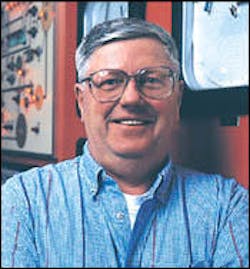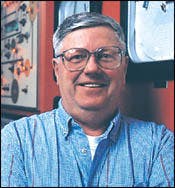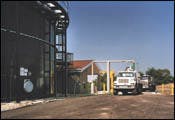Mixing System Reduces Cost, Improves Sludge Pumping
Concerns about sludge storage and mixing compelled the wastewater treatment plant in Denmark, WI, to upgrade its facilities in 1992. Faced with the prospects of increased sludge load and longer sludge storage periods, the plant opted for a design that included a new Aquastore storage tank and a JetMix Vortex Mixing System.
Although there were initial concerns about whether the system would be effective in meeting the plant's upgrade criteria of cost-effectiveness, minimized maintenance and improved operational efficiency, the system has performed beyond expectations, according to Jim Krueger, plant supervisor at the Denmark facility. Savings generated in the areas of operating costs and maintenance have been substantial.
"In eight years, I haven't spent a red nickel on maintenance," Krueger said.
Because the system requires less energy than conventional mixing systems, the plant has also saved more than $18,000 a year in energy costs. Conventional mixers designed for the same purpose need to operate continuously; the Denmark facility operates its system only on an as-needed basis.
Two factors placed new demands on the plant's system and drove the need for the upgrade. First, new EPA regulations that went into effect at the time required storage of biological sludges over the winter. Second, a local dairy, one of Denmark's largest wastewater contributors, switched from producing powdered milk to cheese, a move that significantly increased Denmark's biological load. Specific problems involved:
- Insufficient storage capacity The Denmark plant used anaerobic digesters to stabilize sludge before land disposal, but their volume was insufficient to meet the needs of the plant as well as provide adequate winter storage capacity.
- Mixing capabilities Sludge settles during long-term storage, creating mixing problems that include accumulation of solids, "dead areas" in the center of tanks, or chunks of sludge that rise to the surface. These problems make pumping the sludge for the purpose of land application more difficult.
The JetMix system itself was chosen because it fit with the plant's operational philosophy, which is to purchase equipment that needs minimal maintenance and operator attention and that operates efficiently. Of all the options investigated, the system proved to be the only one that could operate on an as-needed basis, instead of continuously.
The mixing system was developed especially to tackle the kind of problems associated with long-term sludge storage and sludge disposal. The system consists of three rotatable nozzles and two 12 inch inlet suctions in the bottom of the 70 foot diameter by 24 foot high storage tank. Chopper pumps also are used to break up and reduce solids in the sludge.
The system sweeps all areas of the storage tank. A unique flow pattern created by the floor-mounted nozzles combines with the action of the chopper pumps to keep solids suspended or resuspend solids that have settled. The result is a homogenous mix.
The tank and mixing system were installed by the team of Great Lakes Aquastore Systems and Miron Construc- tion Company.
In early December 1992, Denmark placed sludge into the storage tank and allowed it to settle through the winter and early spring. The mixing system was switched on in April 1993, and within 36 hours of startup the solids in the tank were completely suspended. The plant filled its disposal trucks without problems and the smooth, homogenous sludge was ready for land application. When the storage tank was drained, operators discovered no sludge had accumulated at the bottom, nor had any of the mixing nozzles clogged.
At the time, Krueger said the sludge storage system had passed its toughest test with "flying colors." The startup was no fluke. Even after several cycles of filling and emptying the tank, the mixing pattern alone sufficiently resuspended the bottom solids.
At the time, Krueger said the sludge storage system had passed its toughest test with "flying colors." The startup was no fluke. Even after several cycles of filling and emptying the tank, the mixing pattern alone sufficiently resuspended the bottom solids.
What makes the system so effective is the storage tank's circular shape combined with the unique flow pattern created by the JetMix nozzles. With its nozzles mounted in a circular pattern, the mixing system takes advantage of the hydraulic characteristics of circular tanks by creating a "reverse helical" flow pattern.
"Everything is drawn down into the center of the tank, like into a vortex," Krueger said. "Then the nozzles shoot out at the sidewalls at an angle. The sludge goes around the tank and is rolled right back into the center. So you have a vortex going down, plus you've got circular motion, and then you've got nozzles hitting the sidewalls coming up from the bottom, right straight up the sides of the tank."
The system can be fine-tuned to meet specific operating conditions such as sludge thickness and depth. Operators can vary the number of pumps and nozzles used. When continuous mixing is not needed, the jets can resuspend and homogenize thick blankets of accumulated sludge.
"We run it when we are ready to haul out," Krueger said. "We pump it two days ahead of time to emulsify it more. So we're not wasting a lot of electricity."
After eight years online, the system requires only routine maintenance. The plant hasn't had to change the pumps, the bearings, or seals. The tanks don't even need to be cleaned out.
"With other systems, you'd have to go down inside the tanks to clean them out," Krueger said. "We haven't had to do that yet. By just turning on the JetMix nozzles, we can get right down to the concrete. We flush the bottom right off."
Booth 4030


